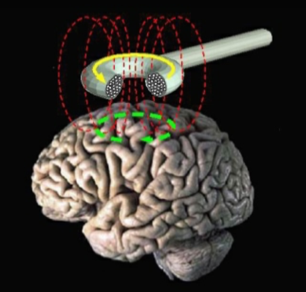TMS for Depression Adds to Therapy Methods
TMS for Depression Adds to Therapy Methods
When psychotherapy and medication are not enough, new therapy options may help.
Posted Jun 11, 2016
Antidepressant medication, often SSRIs like Prozac or Zoloft, and cognitive-behavioral therapy relieve depression
in many patients, but not all of them. So wouldn't it be a big step
forward to find an additional kind of treatment that might benefit
others? One answer might be TMS, or Transcranial Magnetic Stimulation,
available only for the past few years.
It's not science fiction, but based on the scientific observation that an electrical current through a coiled wire induces a magnetic field at a right angle to the coil. That's how most old-fashioned doorbells work. The same principal can be applied by placing a coil just outside the head so the magnetic field can affect nerve cells in the brain just below the coil. If activity in one brain region, like the right frontal area, leads to symptoms of depression, then inhibiting that area with the proper magnetic pulses might relieve those symptoms. So could exciting an area that has opposite effects.

In fact, that has been the finding in several studies, so much so that the FDA has approved its use for this purpose and it is available in some psychiatric practices. Clinical improvement for about 50% of patients treated has been reported.
Of course, it's not that simple. Most recommendations are to consider this treatment for treatment-resistant depression, with symptoms that have not responded to psychotherapy, especially cognitive-behavioral therapy, or to several trials of different antidepressant medication. It takes frequent treatment sessions for weeks, costs a lot, and is only covered in some insurance plans. Like medication, it comes with warnings of possible if infrequent side effects, for example fainting or seizures.
You might be associating this brain stimulation with electroconvulsant therapy, or ECT. But it's not the same, since ECT involves convulsing part of the brain by sending electric current applied by electrodes contacting the scalp, has its own indications, benefits, and warnings, and like TMS requires a specialized medical setting.
You might also hear about a method that sends a smaller electric current applied by electrodes contacting the scalp, often prescribed by a physician, used at home, and less expensive. This method is called Transcranial Direct Current Stimulation, or tDCS. More about this in the future.
These are simplifications. We can ask about the different roles of right and left frontal cortex, which neurons are affected by TMS, and whether these roles differ in the left-handers for whom left and right brain functions are reversed (the left brain is usually dominant for verbal functions in righties). We can compare this treatment to the more visible effects of stimulating the brain's motor cortex to contract muscles.
But here's a take-home thought: there are exciting new possibilities in addition to traditional treatments for depression.
References:
Lefaucheur, JP; et al. (2014). "Evidence-based guidelines on the therapeutic use of repetitive transcranial magnetic stimulation (rTMS)". Clinical Neurophysiology 125 (11): 2150–2206. doi:10.1016/j.clinph.2014.05.021. PMID 25034472.
George, MS; Post, RM (2011). "Daily Left Prefrontal Repetitive Transcranial Magnetic Stimulation for Acute Treatment of Medication-Resistant Depression". American Journal of Psychiatry 168 (4): 356–364. doi:10.1176/appi.ajp.2010.10060864. PMID 21474597.
It's not science fiction, but based on the scientific observation that an electrical current through a coiled wire induces a magnetic field at a right angle to the coil. That's how most old-fashioned doorbells work. The same principal can be applied by placing a coil just outside the head so the magnetic field can affect nerve cells in the brain just below the coil. If activity in one brain region, like the right frontal area, leads to symptoms of depression, then inhibiting that area with the proper magnetic pulses might relieve those symptoms. So could exciting an area that has opposite effects.

TMS diagram..
Source: Eric Wasserman, M.D., NIH/Public Domain
In fact, that has been the finding in several studies, so much so that the FDA has approved its use for this purpose and it is available in some psychiatric practices. Clinical improvement for about 50% of patients treated has been reported.
Of course, it's not that simple. Most recommendations are to consider this treatment for treatment-resistant depression, with symptoms that have not responded to psychotherapy, especially cognitive-behavioral therapy, or to several trials of different antidepressant medication. It takes frequent treatment sessions for weeks, costs a lot, and is only covered in some insurance plans. Like medication, it comes with warnings of possible if infrequent side effects, for example fainting or seizures.
You might be associating this brain stimulation with electroconvulsant therapy, or ECT. But it's not the same, since ECT involves convulsing part of the brain by sending electric current applied by electrodes contacting the scalp, has its own indications, benefits, and warnings, and like TMS requires a specialized medical setting.
You might also hear about a method that sends a smaller electric current applied by electrodes contacting the scalp, often prescribed by a physician, used at home, and less expensive. This method is called Transcranial Direct Current Stimulation, or tDCS. More about this in the future.
These are simplifications. We can ask about the different roles of right and left frontal cortex, which neurons are affected by TMS, and whether these roles differ in the left-handers for whom left and right brain functions are reversed (the left brain is usually dominant for verbal functions in righties). We can compare this treatment to the more visible effects of stimulating the brain's motor cortex to contract muscles.
But here's a take-home thought: there are exciting new possibilities in addition to traditional treatments for depression.
Lefaucheur, JP; et al. (2014). "Evidence-based guidelines on the therapeutic use of repetitive transcranial magnetic stimulation (rTMS)". Clinical Neurophysiology 125 (11): 2150–2206. doi:10.1016/j.clinph.2014.05.021. PMID 25034472.
George, MS; Post, RM (2011). "Daily Left Prefrontal Repetitive Transcranial Magnetic Stimulation for Acute Treatment of Medication-Resistant Depression". American Journal of Psychiatry 168 (4): 356–364. doi:10.1176/appi.ajp.2010.10060864. PMID 21474597.

Comments
Post a Comment